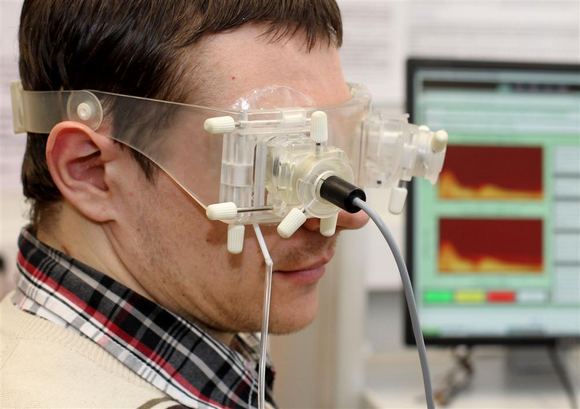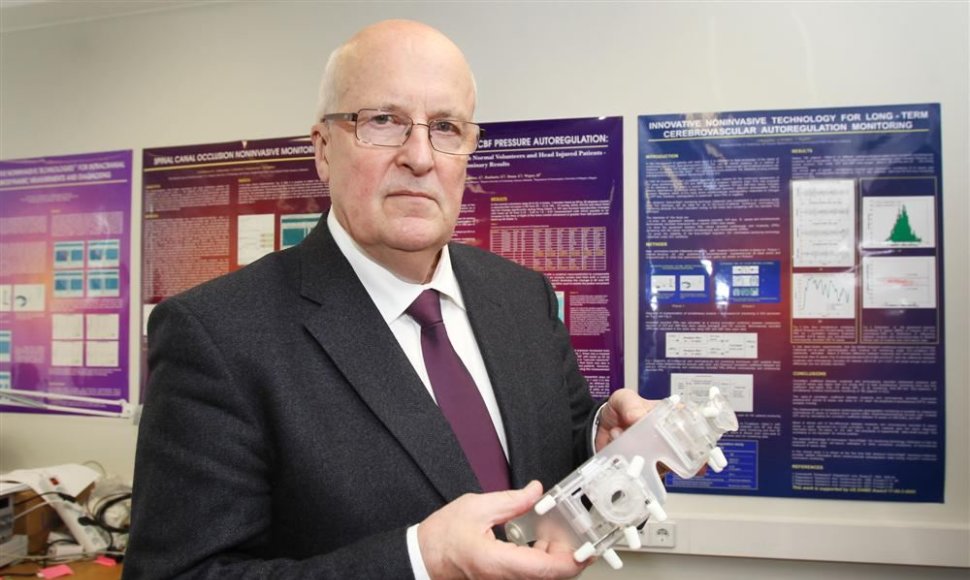The World Health Organization has named head traumas the pandemic of our century. Not only is it the most common cause of death for young people (under 45), especially in the economically developed countries, but also a source of great financial burden, topping tens of billions of dollars in the US and Europe each year.
Even though setting up neurosurgical units and stuffing them with state-of-the-art technology has helped bring down the number of deaths caused by heavy head injury from 50 to 5 percent, many of the survivors still remain permanently disabled. This is due to secondary brain damage – after a trauma, brain can undergo sudden swelling, obstructing blood flow and causing irreversible brain alterations in as little as several minutes or even seconds. Without proper blood supply, neurons, or brain cells, day and do not regenerate.
Measuring brain fluid pressure
Brain swelling can be monitored by following changes in intracranial pressure (pressure inside one's skull). For over a decade, this has been possible by performing an invasive procedure and sticking a sensor directly into one's brain. The method, however, is rather slow, complicated, expensive, and may result in complications, if an infection sets in. Besides, it is inapplicable on site, which is a drawback as head traumas usually happen outside sterile operating rooms.
We are holding talks with major medical companies, like General Electric Medical, Philips Medical, we are in contact with NASA, we receive funding from the US Department of Defense, we keep winning European projects.
Therefore, scientists from all over the world have and still do spend much effort in attempts to find a way of monitoring intracranial pressure non-invasively. So far, only one group of scientists has been successful in the pursuit – one headed by Professor Arminas Ragauskas of Telematics Laboratory in Kaunas Technology University (KTU).
The US military and NASA have worked hard trying to find a way to check brain pressure fast and simply, yet none of their experimental technologies have passed clinical trials.
A multidisciplinary group of scientists from Kaunas, meanwhile, based their research on a 1904 non-invasive artery blood pressure measuring procedure, developed by American scientists Joseph Erlanger, who was awarded the Nobel Prize in 1944.
“After much research, we have discovered one artery that can be used in measuring intracranial pressure. It leaves from one's brain and supplies blood to one's eyeball. The vessel has two segments – one in the brain, another, on the outside of the skull. By monitoring what is happening in both intracranial and extracranial segments, we can create “scales” to measure brain pressure,” prof. Ragauskas sums up his invention.
Metrological cues
The idea is rather basic, so why has it taken so long for someone to think of it? “Because biophysisists and medical students are not trained in metrology – a science of measurements and error margins. And they are the ones with highest stakes in the development of these technologies. We've entered an inter-disciplinary area, but, having enough experience in various measurements, we were the first ones to find a solution suitable for clinical application in war and aerospace medicine,” prof. Ragauskas says.
In the Soviet times, he and his colleagues have worked in various defense and space programs, developing super-accurate meters for physics and industry. After the independence, the flow of Soviet contracts dried out, so he had to look for new areas.
“We switched to biophysics instantly. Until then, my area of expertise had been radiotechnology, semiconductor physics, hydrodynamics, surface physics, ultrasound. We had to measure something everywhere,” prof. Ragauskas recalls. He entered medicine in 1991-1992 and as early as 1995, the Kaunas team filed their first invention with the US patent office. This was independent Lithuania's first patent in the US.
Hopes in new EU fund
The technology developed in the KTU Telematics Laboratory is based on intricate ultrasound measurements and has been patented in the US, Europe, and Japan. Its accuracy has been supported by clinical trials, the scientists have already constructed prototype devices and Lithuania should start mass-producing them in the coming years.
“We have global recognition, too. We are holding talks with major medical companies, like General Electric Medical, Philips Medical, we are in contact with NASA, we receive funding from the US Department of Defense, we keep winning European projects – and manage to retain all of our intellectual property rights in Lithuania,” prof. Ragauskas, who is a board member of many international brain research organizations, enthuses.
However, introducing a product to a massive international market is more difficult than it might seem. “We have three hurdles to overcome: To secure sufficient funding; to create visual design for the product; and to get the CE and FDA certificates that are tickets to the EU and US markets.” he says.
Neither the university, nor the state can provide sufficient funding. Banks will not give credit without collateral. Venture capital funds would gladly give millions of dollars, but in exchange the Lithuanians would have to sign off much of their intellectual property rights.
“We hope that our lives will be made much easier by the soon-to-be-launched EU program Horizon 2020, designed specifically for spin-offs and start-ups,” prof. Ragauskas remains optimistic. At the moment, his project is supported by the European Commission and several American agencies.
Protecting the secret
Before they launch the coveted innovative device into mass production, the Kaunas scientists have to keep their guards up and not give away expensive secrets.
“There is a part of clinical trial data that are hard to keep secret, because one of the terms of the EC funding is that you must publish some of your research to prove that the money was used properly. It's a slippery game,” the scientist admits.
The most valuable part of the technology, known only to its creator, is the original software and hardware. “We do not even patent this part, because patenting, too, amounts do disclosing information. Foul play might ensue. The only chance of protecting the invention is by keeping the know-how part secret,” Ragauskas advises his colleagues.
Off to space
The KTU scientists have also patented a technology for non-invasive brain bloodstream autoregulation monitoring that should, in conjunction with intracranial pressure measuring methods and other non-invasive procedures, form part of a more complex technology to be used in war medicine and space exploration.
For instance, if doctors fail to diagnose how an explosion affected a soldier's brain, he might die at any moment from brain hemorrhage or edema, despite appearing relatively stable. Therefore, doctors must be able to see what is going on in the brain within the first ten minutes after a trauma – the “golden minutes.”
Another major player eying the Lithuanians' invention is NASA. Over ten years ago, it announced that under microgravitation in outer space, the human brain had no mechanism to withstand blood pressure maintained by the heart, so the brain slowly swelled.
“What does it mean for space travelers? The brain swells. The optic nerve, connecting eyeball to the brain, swells as well. Astronauts slowly lose their sight, they can even go blind. This has been observed after 6-month flights, but it can also occur after a month in space,” says Ragauskas, who has been invited to join a group set up by NASA and charged with solving the brain swelling problem.
If the two parties work out the financing, the non-invasive brain bloodstream monitoring device invented by the Kaunas scientists might find its way to space shuttles.
International orientation
Asta Pundzienė, KTU pro-rector for science, says: “KTU is involved in developing many world-class innovations. These technologies are oriented towards foreign markets – the USA, Japan, China, India – as Lithuania does not have many companies able to use the new technology. They often buy standardized products.
“The most important thing is to make sure that, while commercializing inventions, their intellectual property rights remain with us. The university is developing an infrastructure that should assist scientists in this area, we have a Centre for Innovation and Business. It is crucial that we help find money to take the final step – to turn a working prototype into a commercial product.”
 |
| Eriko Ovčarenko/15min.lt nuotr./The device measuring blood pressure in one's brain. |












